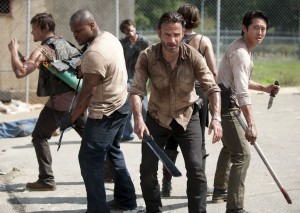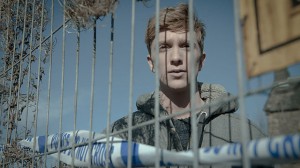Survival School: Cheat Days

All that TV will rot your brain . . . .
Grandparents the world ’round loved to spout that phrase for generations who grew up heavily reliant on television for their entertainment. Gone are the days where kids go outside as option numero uno to battle the dreaded boredom monster. Of course, most adults shun the great outdoors, as well. Why not? There’s the dreaded sun beating down, giving us an unhealthy dose of UV rays. Not to mention bugs the size of a Chihuahua. But how are we supposed to learn important survival skills without first-hand experience in the wild? Easy. Television, of course.
Post-apocalyptic shows are all the rage currently. Which says a lot about how much faith writers have in the survival of the human race. Not all the shows below use zombies as the catalyst for an apocalyptic scenario, but there’s still plenty to learn from each.
The Walking Dead:
Obviously, we’d start with our friends over at TWD for this list.

The show does a bang-up job of demonstrating a nomadic lifestyle for the main cast. How it is nearly impossible to settle in one place with such an unpredictable enemy—both in the walkers and humans who’ve lost grip of their moral leashes. Rick and company have perfected the idea of traveling light, keeping an eye out for possible resupply stops, and only carrying what one can without sacrificing speed. The show also addresses what happens when there is no law, no authority to put their foot down and make people behave civilly. Not everyone turns into a greedy, self-centered jerk. But enough have to speak volumes about where humanities priorities lie. If you don’t have the sheer strength to take what you want, you can go without.
In the Flesh:
The BBC’s newest breakout series takes place after the war with the undead is over and a cure of sorts has been found to return conscious thought to those who’ve risen from their graves.

While there’s not a lot of raw survival skills at work, it is a good show to look at and understand that once the war is over, there’s still many, many small battles left to fight. Post-Traumatic Stress Disorder is a huge part of what the main characters go through. Some were forced to kill loved ones. Others volunteered to fight the undead, not realizing how hard it’d be to not only pull the trigger that first time, but stop killing when the dust settled. Small minds and strict morals rule in the village of Roarton, almost to the point of insanity. It’s a backlash, a way to get a stranglehold on the chaos they lived in for so long. Think of the show as a “How not to act” once the coast is clear and you can settle into some semblance of a normal life again.
Falling Skies:
TNT stepped up to the post-apocalyptic plate with their take on what happens after creatures from another planet decide to make home here on Earth.

The first season picks up the story about six months after the invasion. Mankind as a whole are on the run, hunted by vicious beings called Skitters and their ruthless Overlords. Early on, there is a handful of military on hand to lead and protect civilians. As the show progresses and the Skitters force the survivors to split up and hit the road, those numbers dwindle to nearly nothing. That means Everyday Joes are required to step up and learn what it takes to live on to see tomorrow. The show is packed with survival goodies ranging from locating safe resupply stops to improvised explosives and how to secure a safe haven from attack.
Defiance and Dominion:
Not one to be left out of the loop, Syfy unleashed a pair of post-apocalypse shows in the last couple years. Both shows focus on mankind rebuilding civilization after an advanced being wipes out a huge portion of the population.

Defiance takes place in a world that’s nearly been made inhabitable for humans thanks to the “Arkfall,” which rained alien technology down on Earth and accidentally terra-formed portions the planet. The terra-forming killed many native species of animals and plants, or turned them into something humans cannot eat. Huge stretches of the United States are unpopulated and too dangerous to live in for long periods of time. What cities were salvaged, like St. Louis, hardly resemble huge, sprawling modern cities. Instead they’re little more than a haphazardly thrown together mining town, with housing and buildings made from scrap wood and cargo containers. They’re rebuilding from the ground up, everything from buildings to the laws governing new-comers and humans alike.

Dominion likewise took a well-known city to use as its home base. The Las Vegas seen on the show barely resembles what we know of it today. Vega, the name given to the city by those hiding behind its tall walls, is designed to be a fortress to keep out humans who’ve been possessed by genocidal angels lead by the darkly charming Gabriel. While the buildings are still intact in Vega, there’s a huge food and water shortage. They’re camped in the middle of a desert. Unable to farm the land outside the city’s walls. Yet somehow they make do and almost lead normal lives. Isn’t that the goal of every person after the apocalypse, to find normalcy again?
Under the Dome:
On this CSB drama, the apocalypse is contained to the city of Chester’s Mill when a giant invisible dome is plunked over the town like Tupperware over a spider.

The problems plaguing the townsfolk don’t come from an outside source. It’s all internal strife, greed, and struggle to figure out not only what’s going on with the dome, but how they’re going to survive an unknown amount of time with what food and water are within the dome. Several plague-like scenarios threaten the food supply—ravenous caterpillars, acidic red rain, dust storms, and a burst pipe that drains the water tower. While battling the city’s need for supplies, people are fighting on another front—to retain some semblance of law and order. Difficult to do when the people at the top of the food chain are corrupt and general panic brings out the bad in everyone or gives others the impression they can force their questionable morals on the public. This is a good place to learn how to pool resources for the long haul.
Firefly:
At least the other shows don’t have it as bad as the guys on Firefly.

The Earth was crowded, too crowded, so some folks took it upon themselves to venture into space, finding planets that could be terra-formed to Earth-like conditions. Sometimes it worked, other times it didn’t. Most of the time, the planet’s occupants are too poor to bring in what they need to farm the land. Enter our intrepid heroes. Okay, smugglers. Thieves. Whatever. Malcom Reynolds and his crew are the epitome of the post-apocalyptic attitude. When the mud hits the fan, you keep moving. And occasionally, moving forward and surviving call for a different mentality.
Or as Jayne would say, “Shiny! Let’s be bad guys.”
